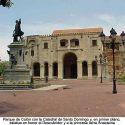– Founding date: 1498.
– Founder: Bartholomew Columbus, brother of the Admiral.
– Category: Capital of the Dominican Republic.
– Current population: 3,000,000 inhabitants.
– The Spaniards settlers in their quest to find gold mines moved from the Isabela to the south across the island of Hispaniola and found several of these mines in the Haina river bed, located about 10 miles west of the current Santo Domingo. This place had a wide and deep outlet, perfect for sheltering ships, so the site was perfect for the management of the exploitation of the mines and their supply and the subsequent export of the ore from its port.
– Historical development: A few years after its foundation, in 1502, it was devastated by a hurricane. Governor Nicolás de Ovando decided to move it to the other side of the Ozama River. This city can be said to have been the initial base of the Spanish conquest of America, since the first expeditions of conquest and exploration to Puerto Rico, Jamaica, Cuba, the Darien and the Yucatan departed from here by important personalities such as Diego Velázquez, Hernán Cortés, Alonso de Ojeda or Rodrigo de Bastidas. It should also be highlighted its importance for being the headquarters of political and economic organizations such as the Casa de Contratación and the Real Audiencia. The first university of America was also founded in this city in 1538, when the time of the conquest was not yet over.
The best architects and masons were brought from Spain for its construction and development, making wonderful architectural works such as the Ozama Fortress (1502), the San Nicolás de Bari hospital (1503), the Cathedral of Santa María la Menor (1520) or the monastery of San Francisco (1523).
In 1586 it was looted by the pirate assassin Francis Drake and his cohort of criminals destroying much of its urban layout and ruining its inhabitants.
From the third part of the 16th century onwards, both Santo Domingo and the Hispaniola island began to lose importance due to the exhaustion of the mines and the fact that economic interest shifted towards the continent in favour of the rich gold and silver mines of Nueva España and Peru. The economy then tried to survive by intensive cultivation of sugar cane and tobacco.
– In this city lived: Christopher Columbus, Rodrigo de Bastidas, Alonso de Ojeda, Hernán Cortés, Francisco Pizarro, Francisco Davila, Diego Colón, María de Toledo, Antonio de Montesinos, Vasco Núñez de Balboa, Ponce de León among others.
– Places to visit: The Plaza de España with its Alcazar de Colón, the Museum of the Royal Houses (old Audience and Captaincy General) and the ruins of the old port of the XVI century, the Park of Colón with the Cathedral Primada de América, the street of the Ladies with its Ozama Fortress, the Felipe Neri hospital, the ruins of San Francisco Monastery, the Casa del Cordón and the Nicolás de Ovando home (present Nicolás de Ovando Hotel).
